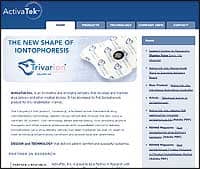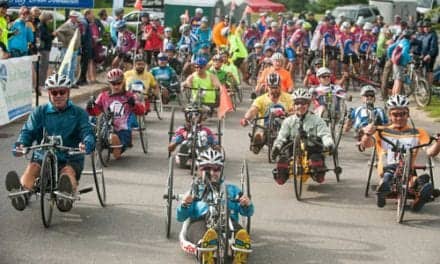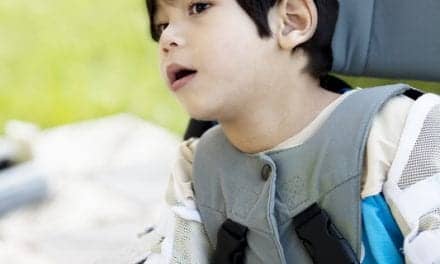by Jackie Skirkanich, PTA, Janine Volpe-Clarkson, MS, CCC-SLP, and Alexandra Waller, MS, OTR/L
Headquartered in Wallingford, Conn, Gaylord Specialty Healthcare is a rehabilitation-based healthcare system that operates the only CARF-accredited stroke specialty program in Connecticut for both inpatient and outpatient care. As a means to optimize the functional progress of patients who led very active lives prior to their debilitating stroke, Gaylord established its Young Stroke program with a focus on an aggressive and highly individualized plan of care.
Young Stroke Program ElIgibility
This name, “Young Stroke,” can be deceiving since qualification for the program depends mostly on the patient’s baseline before the stroke, rather than age. A stroke patient of any age may be considered a candidate for Gaylord’s Young Stroke program if that person was significantly and actively employed, or a student or primary caregiver at the time of the stroke. The complexity of the patient’s stroke is also taken into consideration in determining eligibility for the program.
Patients who participated in Gaylord’s Young Stroke program last year spanned from age 17 to 81 years, with an average age of 55 years. The patient population that fits the Young Stroke criteria generally has fewer co-morbidities and a more active baseline than those in Gaylord’s general stroke population. The program’s more aggressive and highly activity-specific therapies take advantage of the greater energy and resilience of these patients.
Aggressive, Customized Therapy
The Young Stroke program is a segment of Gaylord’s inpatient stroke program. If appropriate, Young Stroke patients work on regaining or improving the specific skills they need to achieve their goals of returning to school, work, or caregiving.
When working with students, for example, therapists may focus on helping them find adaptive techniques or equipment to help them take notes and exams and determine what further recommendations can be made to their school to ensure that they have the best chances of success.
A primary caregiver for a very young child may engage in activities related to picking up the child, feeding the child, diapering, bathing, or transferring the child to a car seat or crib. Someone whose career required them to work on a computer might practice typing or work on certain spreadsheets or programs. Their therapists will help determine if they need to have adaptations for workstations or one-handed techniques.
Why Young Stroke?
A 2016 guideline from the American Heart Association (AHA) and American Stroke Association (ASA) states that approximately 20% of strokes occur among individuals of vocational age. Vocational roles, the guideline explained, provide an identity and contribute to increased self-esteem and life satisfaction.
Further Reading: Young Stroke Program: Path to Get Back into Action
The AHA and ASA also report the number of individuals who were working before their stroke and returned to work after their stroke varies from 20% to 66%. Included in the most frequently found factors associated with return to work are many of the skills emphasized by the Young Stroke program, including independence in activities of daily living (ADLs), good communication skills, and good higher-level cognitive skills and processing speed.1
After a Gaylord physiatrist determines whether a patient meets the Young Stroke program criteria, they—together with a team of interdisciplinary experts from physical therapy, occupational therapy, speech therapy, and recreational therapy—will create a plan of care and potential goals based on the patient’s pre-injury societal roles and baseline activity.
Kevin: A “Young Stroke” Case Study
Patient Kevin came to Gaylord Specialty Healthcare in September of 2019 after suffering a left basal ganglia infarct. The 65-year-old was an avid runner and skier and a career-long executive and chief executive officer of a booming toiletry manufacturing company that sells its product on some of the nation’s largest online retail sites. Kevin manages a small staff and is frequently invited to deliver motivational talks to college business students about overcoming challenges as an entrepreneur.
Kevin spent 2 weeks in an acute care hospital before being transferred to Gaylord Specialty Healthcare. He was unable to move his right arm or leg due to hemiparesis. Additionally, he presented a memory deficit, was affected with dysarthria, and was NPO at the time of his arrival. He made his goals clear from the beginning: He wished to return to his company on a full-time basis, resume his motivational speaking, and be physically active once more. He was deemed to be an excellent candidate for the Young Stroke program.
Throughout his three-and-one-half-week-long inpatient stay at Gaylord’s long-term acute care hospital, Kevin was immersed in an intense, highly customized, interdisciplinary plan of care including physical, occupational, and speech therapy that propelled him well on his way to achieve his goals.
Physical Therapy
The role of the physical therapist in the Young Stroke program is to assess their patient’s mobility, their limitations, and to procure the most recovery possible out of the patient’s deficits. Physical therapy for Young Stroke patients tends to be considerably more aggressive than that of the general stroke program as the population generally has greater endurance and fewer comorbidities.
Kevin’s first few therapy sessions were initially contact-guard assist, but a vigorous land-based therapy regimen quickly helped him become more independent. Aquatic therapy was soon added with focus placed on moving one limb to the contralateral side to promote improved core strength and coordination with weight-bearing functional mobility tasks.
As is often the case for stroke patients who make a sudden transition from an active to a sedentary lifestyle, Kevin experienced considerable stiffness. The 90-degree pool temperature and numerous warm-water jets considerably helped promote soft-tissue extensibility in his lumbar musculature.
As Kevin became increasingly tolerant of the aggressive therapy program, he was able to perform exercises including light plyometric drills and lunges in the hospital’s body-weight support system, to promote lower extremity unilateral stabilization and balance.
On his last inpatient day at Gaylord, Kevin was able to jog in the body-weight support system for the first time since the stroke and independently walk out of Gaylord Specialty Healthcare’s doors.
Occupational Therapy
In occupational therapy, Kevin worked toward independently performing activities of daily living such as showering, self-dressing, and more. But as a Young Stroke patient, much additional emphasis was also placed on regaining some of the highly specific skills that would help him successfully return to his career.
Kevin expressed a great desire to focus on arm control in hopeful preparation for a return to driving. Also, as a corporate CEO who “signed checks all day long,” he expressed specific, considerable interest in being able to legibly sign his own name.
Kevin’s occupational therapist developed a rigorous and customized exercise plan that included weights, resistance bands, and grippers to improve strength. Each day in therapy, Kevin practiced signing his name and writing numbers repeatedly. He often played a popular word-based board game with his therapist that not only required him to think critically, but also write his answers on paper. At first, the 65-year-old patient’s words were nearly illegible. As the weeks progressed, so, too, did his handwriting.
To further improve arm and hand control in preparation for driving, his occupational therapist recommended use of the hospital’s high-tech multidisciplinary therapy touchscreen program to work his coordination, balance, and hand/eye coordination. As he neared discharge, Kevin took, and passed, a pre-driving screen that tests reaction time, cognition, and attention using the same multidisciplinary therapy program.
Speech Therapy
A FEES assessment conducted before Kevin’s transfer to Gaylord revealed a severe pharyngeal stage dysphagia and silent aspiration with pureed foods and thin liquids. Due to this finding, Kevin arrived at Gaylord NPO. Kevin’s speech-language pathologist began an aggressive pharyngeal strengthening exercise routine and incorporated the use of a swallowing biofeedback system every day.
A modified barium swallow study 1 week later revealed that Kevin could transition to a PO diet. An NDD3 diet with thin liquids was recommended with the use of swallowing strategies. Near the end of his three-and-a-half week stay, Kevin underwent another modified barium swallow study and was upgraded to a regular-consistency diet without the need for strategy use.
Kevin was found to have a memory deficit that was addressed with memory recall exercises. Memory strategy use was discussed and implemented. Other assessments revealed that Kevin had significant deficits in oral-motor functioning and deficits in motor speech functioning. His speech-language pathologist aggressively worked to improve his mild-moderate oral motor deficit with electrode stimulation to the facial muscles and introduced oral exercises. Speech intelligibility strategies and tongue twisters were also introduced and practiced to improve motor speech.
Goals Fulfilled
Like many of his peers in Gaylord’s Young Stroke Program, Kevin was discharged to home at the end of his three-and-a-half-week stay at Gaylord Specialty Healthcare and transitioned to Gaylord’s outpatient therapy program for continued improvements. As of January 2020, fewer than 4 months after his stroke, Kevin plans on returning to the helm of his personal products business on a full-time basis. RM
Jaclyn Skirkanich, PTA, received an associate’s degree in Physical Therapy (PTA) from Naugatuck Valley Community College in 2014, a bachelor’s degree from UCONN in 2019, and is currently enrolled in a doctoral physical therapy program at Mercy College. She has been employed at Gaylord Specialty Healthcare since 2017.
Janine Volpe-Clarkson, MS, CCC-SLP, earned a Bachelor of Science from The College of Saint Rose and a Master of Science from Southern Connecticut State University. She is employed by Gaylord Specialty Healthcare as a speech-language pathologist, is the Center Coordinator of Clinical Education for inpatient speech-language pathology, and serves on the neurobehavioral committee.
Alexandra Waller, MS OTR/L, received her bachelor’s degree and master’s degree from Springfield College. She has been employed as an Occupational Therapist at Gaylord Specialty Healthcare for the past four years, is an aquatic therapist and member of the neurological committee. For more information, contact [email protected].
Reference
1. AHA/ASA Guideline. Guidelines for Adult Stroke Rehabilitation and Recovery. Available at: https://www.aan.com/Guidelines/Home/GetGuidelineContent/744. Accessed January 30, 2020.
Plateau or Progress? Objective Gait Data Helps Decide
by Frank Long, MS
The best stroke rehabilitation outcomes are no accident. They are informed by measures of performance that can help determine whether a patient is continuing to make functional gains or has reached a plateau. This is especially important for recovering the ability to walk, a common rehab goal among post-stroke patients and one that objective temporal-spatial measure of gait can help bring into focus.
A 2017 study spotlights the clinical value of objective gait data in helping determine the effectiveness of modified standardized task-specific training (MSST) on gait recovery post-stroke.1 MSST is a progressive gait training program for outpatients that includes the use of a treadmill to address gait dysfunction.1 The objective gait data gathered for this study helped researchers compare the performance of two study subjects using different gait-recovery programs for the purpose of gauging the effectiveness of MSST as outpatient treatment.
What the Data Measure
A computerized mat was used to gather objective temporal-spatial gait data about each study subject. The temporal-spatial data collected included measures for velocity, cadence, step length, step length differential, double limb support average, single limb support, toe in/out, and base of support average. Study subjects were tested with the computerized mat at 10 weeks, 6 months, and 10 months.1
Both participants in the study demonstrated significant changes in temporal-spatial parameters of gait, a conclusion the authors reached in part by using objective data generated by the computerized mat. Other evaluations used include the 6-Minute Walking Test, Stream, Functional Independence Measure, locomotion/stairs subscale, Stroke Impact Scale, Modified Ashworth Scale, and lower extremity sensation.1
An Open Window
Clinical decision-making evidence is vital to healthcare, and this study demonstrates that objective data about the temporal-spatial measure of gait can help evaluate the effectiveness of therapy. This data may be especially helpful in evaluating progress during the 2-month window after stroke when critical motor learning occurs. It is important to economize the oftentimes limited number of reimbursable visits available during that period, which clinicians can do by using objective temporal-spatial gait data to help set recovery goals and move patients toward them while the window remains open. RM
Reference
1. McCain KJ, Shearin S. The impact of modified standardized task-specific training (MSTT) on gait outcomes in persons with subacute stroke: A case report. Cogent Medicine. 4:1, DOI: https://www.doi.org/10.1080/2331205X.2017.1417669





